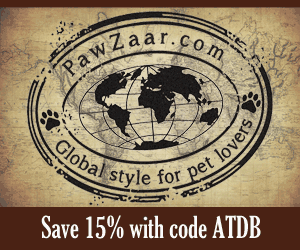 |
| © AllThingsDogBlog.com Healthy Food Helps Build Attentive Minds |
Today I'd like to share a little about the rules that the U.S.D.A. places on pet food makers that produce organic food. Much of this has been excerpted from various pages on the USDA.gov website where the National Organic Program is detailed. There's a lot there to digest, so I'm going to help you get to the meat of it--pun intended! The material in black below has been excerpted from the webpages that are linked in this article, in order to make for swifter reading. Let's start with some general definitions of organic standards:
Organic crops. The USDA organic seal verifies that irradiation, sewage sludge, synthetic fertilizers, prohibited pesticides, and genetically modified organisms were not used.
Organic livestock. The USDA organic seal verifies that producers met animal health and welfare standards, did not use antibiotics or growth hormones, used 100% organic feed, and provided animals with access to the outdoors.
Organic multi-ingredient foods. The USDA organic seal verifies that the product has 95% or more certified organic content. If the label claims that it was made with specified organic ingredients, you can be sure that those specific ingredients are certified organic.
What About Other Labels?There are other voluntary labels for livestock products, such as meat and eggs. Animal raising claims must be truthful and not misleading. USDA’s Food Safety Inspection Service verifies the truthfulness of these claims:
Free-range. This label indicates that the flock was provided shelter in a building, room, or area with unlimited access to food, fresh water, and continuous access to the outdoors during their production cycle. The outdoor area may or may not be fenced and/or covered with netting-like material. This label is regulated by the USDA.
Cage-free. This label indicates that the flock was able to freely roam a building, room, or enclosed area with unlimited access to food and fresh water during their production cycle.
Natural. As required by USDA, meat, poultry, and egg products labeled as “natural” must be minimally processed and contain no artificial ingredients. However, the natural label does not include any standards regarding farm practices and only applies to processing of meat and egg products. There are no standards or regulations for the labeling of natural food products if they do not contain meat or eggs.
Grass-fed. Grass-fed animals receive a majority of their nutrients from grass throughout their life, while organic animals’ pasture diet may be supplemented with grain. Also USDA regulated, the grass-fed label does not limit the use of antibiotics, hormones, or pesticides. Meat products may be labeled as grass-fed organic.
Pasture-raised. Due to the number of variables involved in pasture-raised agricultural systems, the USDA has not developed a federal definition for pasture-raised products.
Humane. Multiple labeling programs make claims that animals were treated humanely during the production cycle, but the verification of these claims varies widely. These labeling programs are not regulated under a single USDA definition.
No added hormones. A similar claim includes “Raised without Hormones.” Federal regulations have never permitted hormones or steroids in poultry, pork, or goat.
Which fertilizers are allowed in organic crop production?
The Organic Foods Production Act of 1990 prohibits the use of synthetic fertilizers—including ammonia salts and urea—in organic crop production. Organic farmers typically use natural fertilizers as needed, including chicken litter, compost, and fish meal. Sustainable management practices, such as crop rotation and cover crops, reduce the need for fertilizers and other inputs on organic farms. For example, a farmer may plant a crop that needs a lot of nitrogen (such as corn) on a field one season, and then a nitrogen-fixing crop (such as alfalfa) the next to replenish the soil.
Another question that often comes up is in regard to GMOs--genetically modified organisms. So far, the USDA continues to ban use of GMOs in organic produce, even if it meets all the other qualifications. This is one guideline that is definitely under fire. If you'd like to educate yourself more on the woes of GMOs as well as the history and status of our nation's food production, please grab a copy of The Hundred Year Lie, by Randall Fitzgerald. An extremely education read, you'll be engrossed, enlightened and ready to make some serious changes in both your food and fido's. Bring your highlighter along when you plan to read it; you'll need one.
I'm not actually sure why they chose to leave the differences so unclear when they updated the website. I'd love to hear from anyone who can shed some light on this little conundrum. Now let's get back to what it takes to become organic, in whatever way is chosen.
 |
| courtesy usda.gov |
Any land used to produce raw organic commodities must not have had prohibited substances applied to it for the past three years. Additionally, buffer zones are often in place to protect land, water and other natural resources. Until the full 36-month transition period is met, the farmer may not:
- Sell, label, or represent the product as “organic”
- Use the USDA organic or certifying agent’s seal
If you're truly interested in a snoozer of a read, you can wade through the National List of Allowed and Prohibited Substances of the National Organic Program here. Be warned; this is not enjoyable reading; however, there may be some gems of interest to you.
Now I'm going to dangle a carrot. If you'd like to learn the pros and cons of buying each of these two types of organic pet food, I'll dish that info and more about our choices here at All Things Dog Blog. Join me on October 6 for the next step in this series on Dogs Going Green. If you've missed our earlier editions, you can catch up here:
Happy tails,









































1 comments:
Anonymous said...
On the topic of dog food labels, I recently learned a lot of good info pertaining to the ingredient lists.
I never knew that they were listed in order of their weight, a fact that can be very misleading when it comes to the amount of actual nutrients that are found in your dogs food, due to the rendering process!
Post a Comment